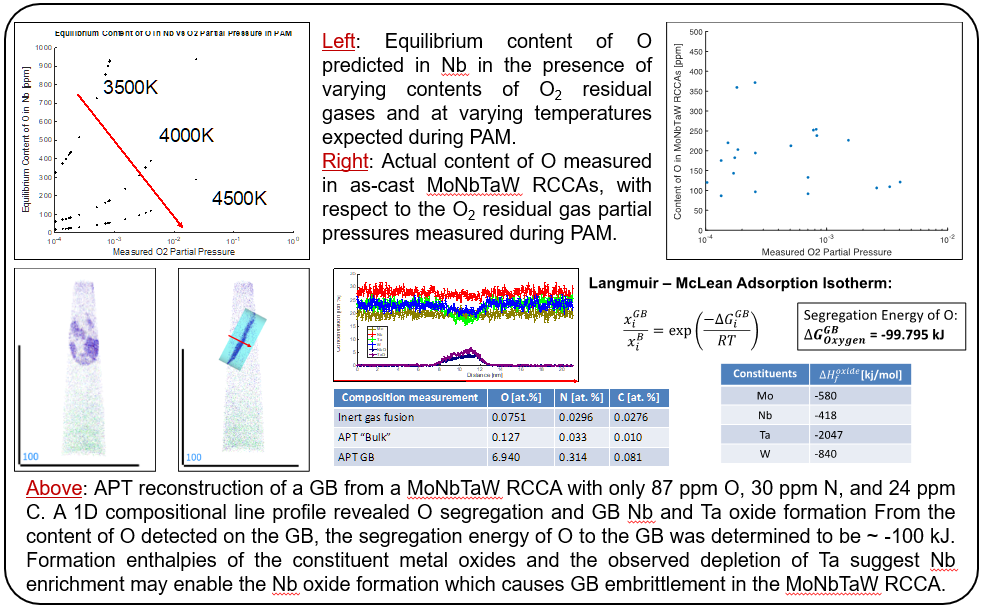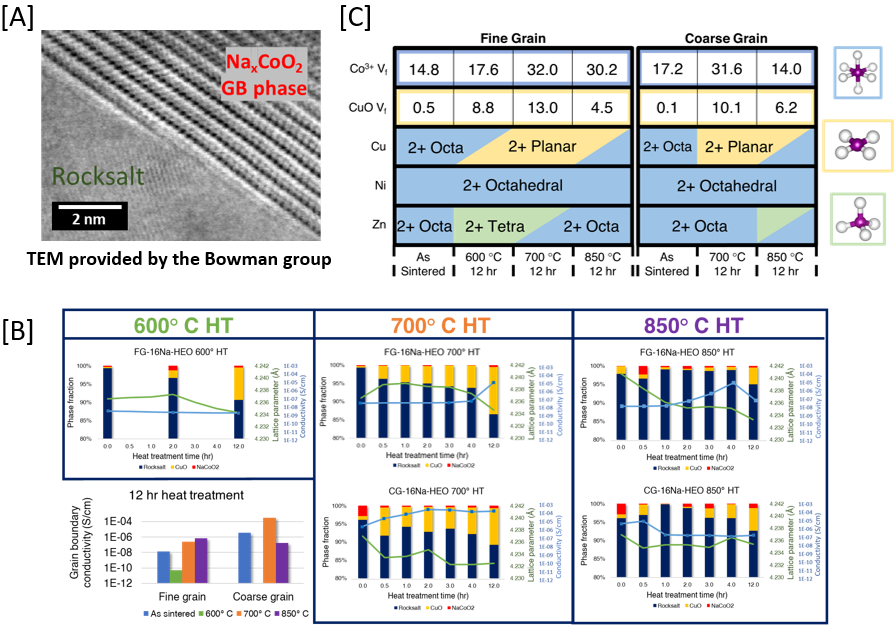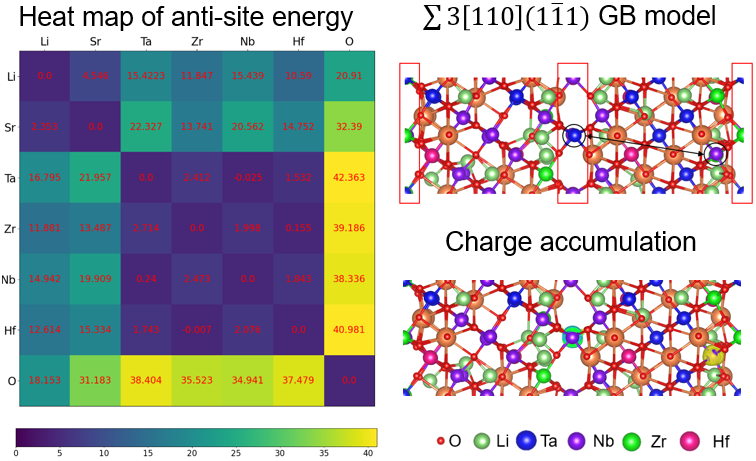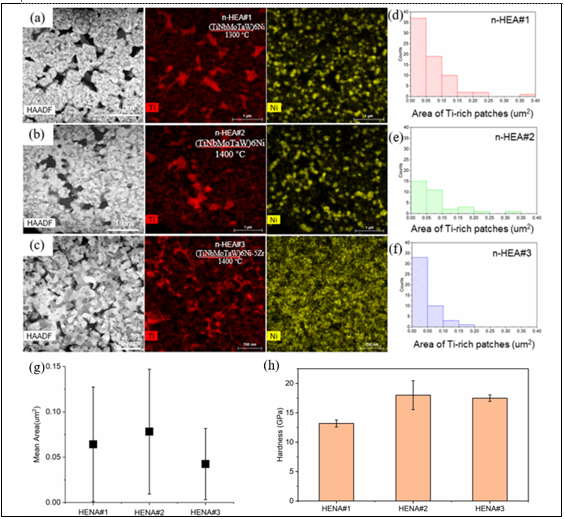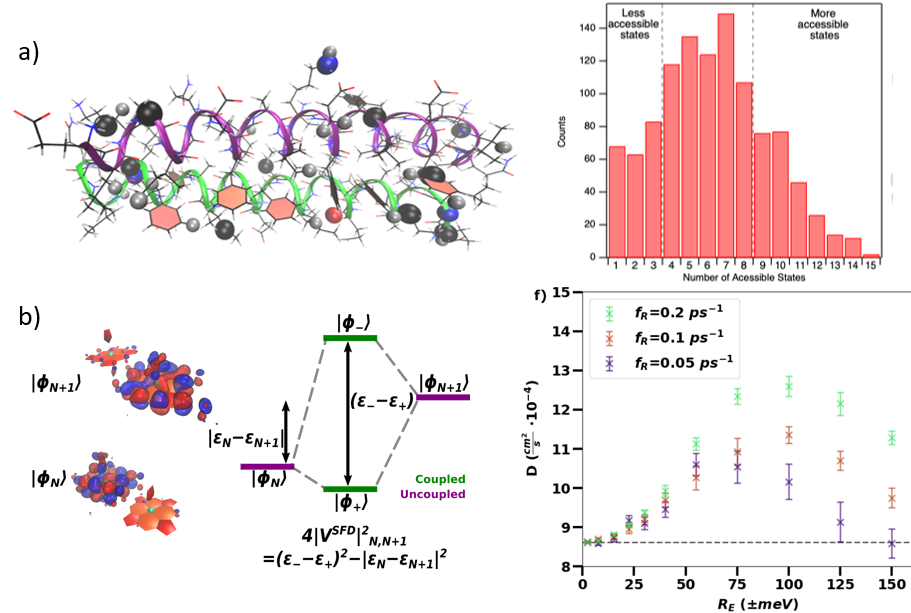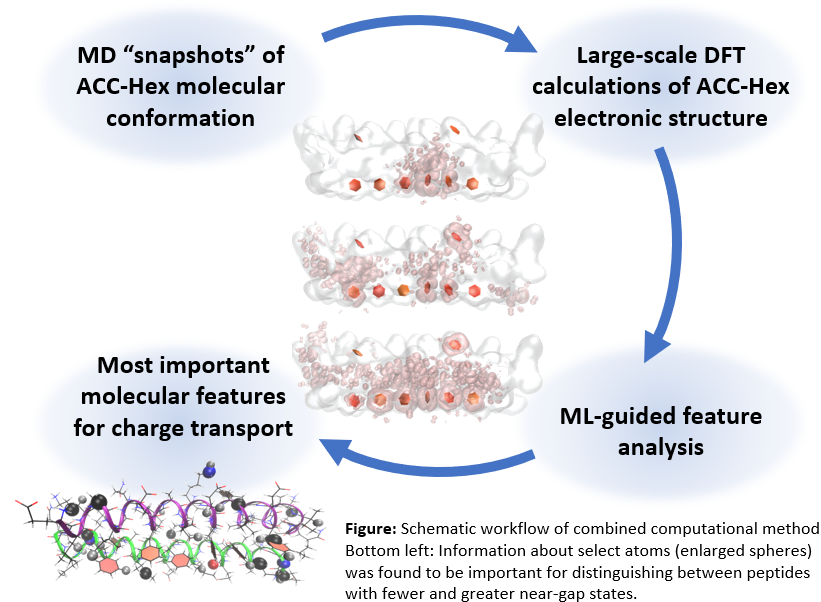Research Highlights
2024 IRG-1: The sources and control of interstitial impurities during arc melting of refractory complex concentrated alloys
Apr 19, 2024
§Refractory complex concentrated alloy (RCCA) exploration and development has been enabled by plasma arc melting (PAM) §Sources of interstitial impurities and variations in PAM are not well documented Key Findings: §Established understanding of the driving forces for...
2024 IRG-1: Conductivity enhancement in sodium-doped multi-phase high entropy oxides
Apr 19, 2024
Our previous work revealed that the (Co,Cu,Mg,Ni,Zn)1-xNaxO system exhibits an electrically conductive layered grain boundary phase at high-temperature processing conditions (Figure A). This boundary phase is a P2 type NaxCoO2 layered structure that has not been...
2024 IRG-1: Observation of Grain Boundary Electrostatic Characteristics in Perovskite Solid-State Electrolytes by Four-Dimensional Scanning Transmission Electron Microscopy
Apr 19, 2024
Grain boundaries (GB), which can significantly hinder Li-ion transport, are the bottleneck of improving solid electrolytes’ ionic conductivity. The atomic structure and electrostatic characteristics of GBs thus become pivotal areas of study in materials science. In...
2024 IRG-1: Interplay of chemistry and structure in complex concentrated alloys
Apr 19, 2024
By increasing the sintering temperature to 1400 °C, the microstructure and chemical distribution of the HENA is significantly optimized. (Fig.1a-b, d-e) By introducing additive Zr into the HENA (sintered at 1400 °C), the microstructure and the compositional...
2024 IRG-2: Understanding the Microscopic Mechanisms Associated with Conductivity in Biological System from First-Principles
Apr 18, 2024
To design improved conductive and bio-compatible nanowires,we aim to understand their electronic structure and electron transfer mechanism, focusing on structure-property relationships. Over the last year, these calculations: •Elucidated the relationship between...
2024 IRG-2: Machine learning-guided investigation of conductivity mechanisms in peptide assemblies
Apr 18, 2024
Certain peptides self-assemble fibers that exhibit long-range charge transport. Thermal fluctuations have been implicated as important in this emergent property.1 We adapted our interpretable machine learning (ML) platform2 to understand how thermal fluctuations...
2024 IRG-2: Bioinspired heme binding peptide fibers
Apr 18, 2024
Natural conductive wires from bacteria are one-dimensional chains of cytochromes – heme containing proteins. To mimic their structure and make synthetic conductive wires, we design heme binding peptide bundles to use as building blocks of self-assembling wires:...
2024 IRG-1: Neural Network Kinetics: Exploring Diffusion Multiplicity and Chemical Ordering in Compositionally Complex Materials
Apr 18, 2024
•We introduce a neural network kinetics (NNK) scheme that predicts and simulates diffusion-induced chemical and structural evolution in complex concentrated chemical environments. •The framework is grounded on efficient on-lattice structure and chemistry...
2024 IRG-2: Electrically Tuned Dissipative Assembly of Nanoparticles in Colloidal Solution
Apr 18, 2024
Electrohydrodynamic (EHD) flow, an electrokinetic phenomenon resulting from an applied oscillatory potential in solution, drives lateral assembly of plasmonic nanoparticles (NP) in response to an electric field gradient on an electrode-liquid interface. •Results...
2024 IRG-2: Elastic Network of Droplets for Underwater Adhesives
Apr 18, 2024
This paper reports: •Kinetically trapped self-assembly of a compartmentalized network of liquid droplets from small-molecule precursors •Liquid-liquid phase separation accompanied by silanol hydrolysis, condensation, and zwitterionic self-association •Hierarchical...
2024 IRG-2: All-atom molecular dynamics simulations of CSH-CSSC fibers (Tobias Group)
Apr 18, 2024
1174 CSH-equivalents (70 % & 100 % converted to CSSC) are cylindrically restrained (Fig. 1) Radius (r) = 27 Å, as informed by Cryo-EM measurements (Patterson group) The composition of the 70% conversion system is informed by previously published...
2024 Shared Facilities: Anisotropy-Driven Crystallization of Dimensionally Resolved Quasi-1D Van der Waals Nanostructures
Apr 18, 2024
The Anton Paar AFM is a compact system with a large sample stage that enables users to detect surface topography down to atomic steps. This AFM not only provides basic surface imaging in both contact tapping mode and contact mode but also several advanced modes...
2024 Seed: CryoEM finds complexity in structural evolution of active materials
Apr 16, 2024
The realization of hybrid chiral and non-reciprocal excitations necessitates the development of new atomically-precise chiral solid state crystals and the understanding of the fundamental optical/electronic states that arise from the resulting structures Developed the...
2024 IRG-2: CryoEM finds complexity in structural evolution of active materials
Feb 8, 2024
Synthetic active materials are designed to mimic complex biological materials such as microtubules. Here, we studied a chemically driven active material using cryo electron microscopy which allowed us to see the structures these materials form at very high resolution....
2023 IRG-1: Compositionally complex perovskite oxides: Discovering a new class of solid electrolytes with interface-enabled conductivity improvements
Jun 28, 2023
• In IRG-1, Luo and co-workers have discovered a new class of solid electrolytes: compositionally complex perovskite oxides (CCPOs). • This collaborative study with Pan, Ong, Bowman, and MRSEC students further investigate the fundamental...
A New Class of Solid Electrolytes Discovered
Jun 23, 2023
A New Class of Solid Electrolytes Discovered Compositionally complex ceramics (CCCs), including high-entropy ceramics, provide a vast compositional space for new materials discovery beyond the classical doping strategy in stoichiometric compounds. Recently,...
2023 Shared Facilities: Li distribution in Li0.375Sr0.4375Ta0.75Zr0.25O3 solid electrolyte mapped by vibrational electron energy loss spectroscopy
Jun 10, 2023
•The new Nion HERMES 200 is an aberration corrected, monochromated scanning transmission electron microscope (STEM) equipped with space- and angle-resolved electron energy loss spectroscopy (EELS), which is the first at a University Shared Facility. •Due to the broad...
2023 Seed: DLP printing of tunable magnetic composites
Jun 10, 2023
• Photosensitive resins containing magnetic nanoparticles were successfully synthesized and used to 3D print composite magnets via Digital Light Processing. The 3D printed cubes displayed in the figure (top) clearly exhibit magnetic response (bottom), with magnetic...
2023 Seed: Structured Strain and Deformations in Van der Waals Quantum Material Heterostructures
Jun 10, 2023
Achievements: • Demonstration of topological phase transitions induced in HfTe5 by uniaxial strain• Demonstration of a new technique to control heterostrain in vdW multilayers via AFM nanomanipulation• Demonstration of photo-induced force microscopy (PiFM)...
2023 IRG-2: Fully Electrically Fueled Supramolecular Living System
Jun 7, 2023
This Work Reports: • The first example of a fully electrically fueled dissipative self-assembly system.• The active systems can be sustained over a long period of time.• The system does not generate any chemical waste.• The active assembly can be spatiotemporally...

